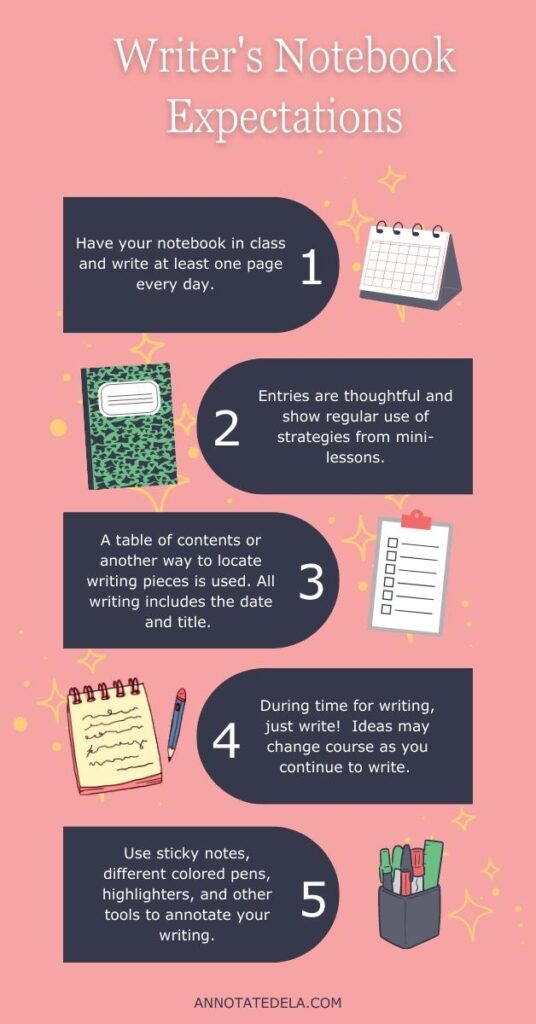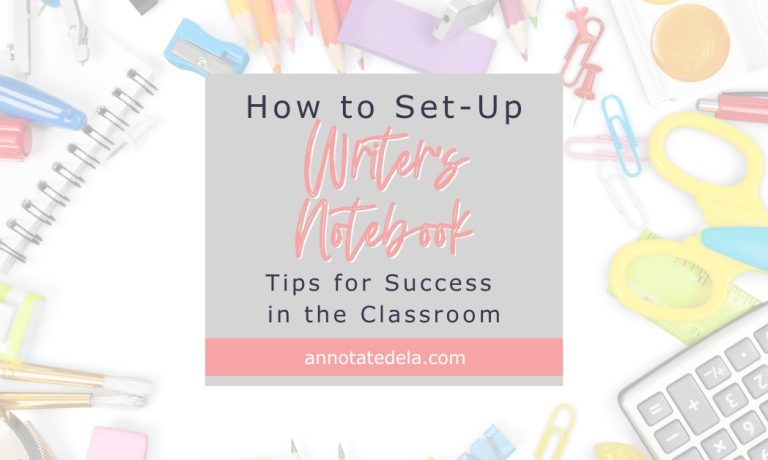Whether you’re a teacher looking to get your classroom writing projects off the ground, or a student wanting to create an effective space for writing practice and reflection, how to set-up a writer’s notebook is essential for getting started. In this guide, we’ll go over the basics of what it takes to set up a successful writer’s notebook.
Want to use writer’s notebooks with intention and meet your student’s writing needs? With the 5-Day Writer’s Notebook Challenge, you can help your students become proficient writers and meet all levels of students where they are! Join me for five days as we transform how you and your students use notebooks!
Find the Right Notebook
Choosing the right notebook is important to create a productive and inviting writing space. The seven key considerations will help guide the notebook decision that is best for you and your students.
The Seven Considerations:
- Are students taking notebooks home? Easily transported?
- Is the notebook easily replaced if it gets filled? Or are you using something that can be replenished and does not fill up (think binder)?
- To decorate or not to decorate – will notebooks be personalized?
- Are the notebooks easy to collect and review?
- How will the notebook be structured?
- Will pages need to be removed or additional pages added?
- Is the notebook easily managed by students?

Some other things to consider for how to set-up writer’s notebook are to look for notebooks with strong internal binding (so pages don’t fall out), plenty of blank pages, any lines you may need, and a sturdy cover. If flexibility is key for you or your classroom, consider spiral-bound or pocket notebooks that allow for additional content―postcards, stickers, drawings―to be tucked in alongside text entries. Remember that there is no wrong notebook; composition notebooks seem to be the best choice in most classrooms (mine included). Students are very creative and will find ways to make the notebook work for them. The notebook choice will also determine how to set-up writer’s notebook.
How to Decorate Your Writer’s Notebook or NOT

To decorate or not to decorate, this is the question…it’s a no-brainer for me – DECORATE! However, some students do not want to personalize, and that is okay too. I leave it up to my students, but I do provide time and supplies in the pursuit of making the notebook their own. Encouraging students to decorate adds a sense of ownership of the physical notebook and what the students eventually put inside. This is a sacred space and should be treated with all the care and love it deserves. It can be as simple as adding their names and pictures of their family, friends, or pets. For the more artistic and crafty students, let their imaginations run wild! This is an important part of how to set-up writer’s notebook; make it special because it is special.
Supplies for Decorating Notebooks
- 1-2 notebooks (I prefer composition notebooks)
- Clear packing tape or contact paper to protect pictures and covers
- Sharpies (permanent markers)
- Tabs to flag sections of notebook
- Sticky notes
- Glue
- Pencil
- Pen
Discuss Writing and Expectations with Your Class

After your learners have gathered their materials, introduce the notebook and discuss how it can help them and their writing. Discuss why they will benefit from keeping these notebooks and what they should use them for. Reinforce the importance of maintaining a neat and organized notebook by explaining that it will make it easier for students to locate notes, ideas, or writing drafts needed for accomplishing classroom tasks. Additonally, expectations of the notebook are important when considering how to set-up writer’s notebook.
Before students dive right into their writer’s notebooks, it’s important to discuss ideas and expectations with the entire class. Talk about why writing is important for grasping concepts and how the notebook will help them do this.
It is beneficial to come up with expectations and norms as a class, it will give students a voice and improve internal motivation if students know they were part of creating the “rules” for the notebooks. Of course, as the teacher you always have the final word and can facilitate successful decision making.
Writer’s Notebook Organization

You can help your students stay organized by labeling each section of the notebook, numbering pages, and creating a table of contents page. I have found that simple organization is the best organization for how to set-up writer’s notebook and we start with two sections – Toolbox and Writing. We do leave 3-4 pages at the front for a table of contents (we number the table of contents with roman numerals).
Then we flag the first page after the table of contents with a tab – “Writing” (this is page 1). Number pages front and back, so a composition book has 200 pages minus the 3-4 pages for the table of contents.
Next, turn to the last page of the notebook and flag it “Toolbox” with a tab. We work from the outside in and it works well. The tricky part is keeping a table of contents and organizing. Some students will continue to use tabs and sticky notes to flag pages. Also, encourage students to do what works, this is when they choose how to set-up writer’s notebook. This is a great opportunity for ownership and finding strategies that work for the individual.
As a teacher and as a class, you have the freedom to organize the writer’s notebooks however you like, so do what works!
Schedule Time For Writing and Reflection Within the Notebook
Once you’ve provided learners with the guidelines and expectations of their writer’s notebook, plan regular opportunities for them to write! This sounds like such a simple thing, but it is the most important and can often feel impossible. With all the demands on the teacher and trying to teach all the things, taking time to just write might feel like a waste of precious class time – I get that! But having students build a collection of writing (and endurance for writing) will be well worth it when it comes time to teach the reading, writing, speaking + listening, and language standards!
How to set-up a writer’s notebook will be personal for you and your students. My hope is that these tips for success help you get started or take your notebooks to the next level! Happy writing!
The magic is in the process!





5 Responses